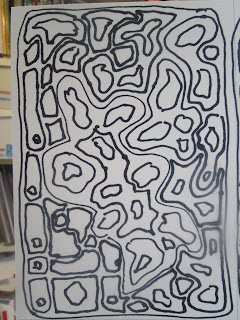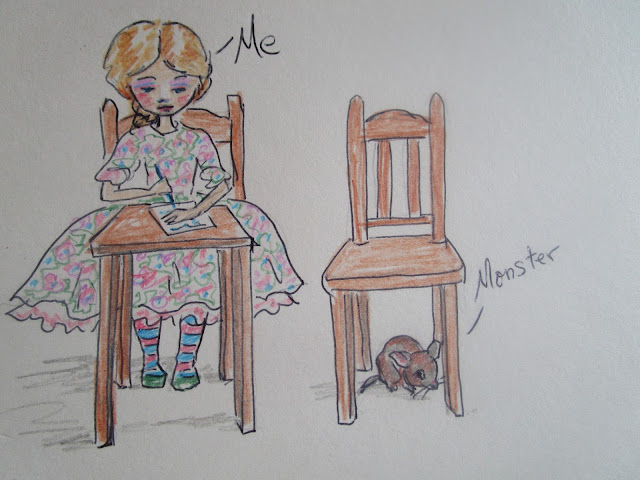Little Miss Muffet
Sat on her tuffet
Calmly writing away.
Along came a spider - no, a mouse
And sat down beside her,
And she didn't know it.....
Until she finished and got up and saw something on the floor, and was about to pick it up --
Miss Muffet doesn't have very good eyes --
And realized the ball was furry....
Stefan!!! Come here!
Put a pan over it!
He did.
Then Miss Muffet called Saint George,
"Please, Slay the dragon!"
He gallantly galloped home from the construction site in the City and slew the monster. Miss Muffet is glad she married him.
We have not had a mouse in the house for years, but a couple of days ago the haulers of wood left the side room door open, and Mom neglected to do her nightly rounds of door checks, so in the night in crept the intruder. Too bad for it.
Drawing Faces, Exercise Two
Some people like scribbles, some don't. It feels disorderly to them. They like one line at time. So, to keep trauma to a minimum, this exercise is for them; but everyone should try it - even I did it. It was trauma to me: "Only one line?! That isn't enough. The first line is for warm up. The second is for practice, and the third is maybe where you want it." Well, I did it anyway.
So this time we try doing single-line shapes.
Gather your mark-maker, with no eraser! - so make that drawing implement a black marker that makes lines that stay down where you put them - and paper, and carbon/graphite/tracing paper, and colored pencils.
Resources: a large face picture from a magazine advertisement, preferably with some shadows.
Process: will be in several steps.
1. On a sheet of paper, draw a closed curve-line shape in each quarter. Then make more around it. Don't fill them in and don't get too detailed. Repeat. Repeat. Repeat. Set these papers aside for a bit.
 |
| Closed line shapes |
 |
| Filling the space (upper left above) with more shapes |
 |
| Another space (lower right of above ) with shapes |
2. Trace the face from your magazine onto your paper, using single black lines around all the features and areas of shadow and highlights. It will look something like a map when you are done. (You may need to do it in pencil first if you are using graphite paper, then trace over with marker.)
3. On your first set of drawings, fill in the bigger shapes with smaller closed-line shapes, at first randomly, then more decoratively. Don't try to make a recognizable picture.
 |
| Same shapes (above), with detail added |
 |
| Details added |
 |
| Details on lower left form |
4. Make copies of your face drawing. Organize four or five colored pencils (not skin tones!) according to value (lightest to darkest).
On the first one, color each shape according to the approximate value you see in the photo. Don't shade; only flat color.
 | ||
| Flat color |
 |
| Varied marks for value |
 |
| Resource picture |
 |
| Drawing with value area marks |
 |
| Main lines in thick lines |
 |
| Detail lines in thinner lines |
 |
| All Tangled |
Goal: To make control people happy and annoy scribblers. No, no. For equality and world peace. No, no, no. Actually it is to make you think with your brain. Some people do that; others of us think - when drawing - mostly with our hands. Ultimately, what you want to achieve is a happy balance between brain and hand. Meaning, scribblers should find their lines getting very close together, indicating the brain is ruling the hand, but the hand is still free to play. For single-line people, they will find that their lines are not so tense and rigid, but can be floating and even wobbly without collapsing the universe (i.e. - needing to be erased and done over).
Most experienced drawers of faces will use this technique of outlining areas of lights and darks all the time that they intend to make a shaded drawing, and sometimes even when they don't, just to physically indicate the contours of the planes of the face (which, for a simple drawing, will mostly get erased afterward).
So this is a very necessary skill to learn: first note the shape of a value, then mark your paper. Brain and hand coordination.




That must have been one sick mouse if Stef could catch it in a pan. The only good mouse is a dead mouse, though, so yay for St. George.
ReplyDeleteInteresting drawing method in this post - it took me a while to realize where you were going with the examples. I prefer scribbling too - a multitude of lines cover a multitude of sins.
Actually it had probably ingested some poison previously, so it was easy to capture. But I am glad it didn't die in some hidden corner.
ReplyDeleteThanks for the comments - "interesting"... as in, "I can't see a use in that; but actually finding those value shapes is extremely useful. You probably do it without thinking about it.
Oh, this looks fun! And I like the Zentangled one...
ReplyDelete